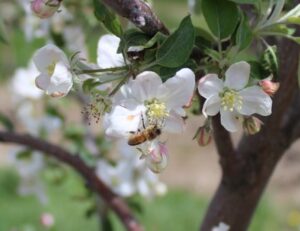Throughout the state, most of us are in some stage of tree fruit bloom and as fruit producers, you all know how important insect pollinators are for ensuring good fruit set and even quality! Whether you’re producing tree fruits, nuts, or small fruit (even grapes, although they aren’t dependent on insect pollinators), we know that the more visits blooms receive, the better. So, as we say every year, to maximize pollination, it’s important to protect and support pollinators in your fruit systems in two key ways: Do not spray pesticides during bloom, especially insecticides, and leave the dandelions and wildflowers in your orchards and yards so the early season bees have extra ‘groceries’ on the landscape to benefit from.
When most of us think of pollinators, we first think of the bees, but there are also many kinds of flies, butterflies, and even beetles that can contribute to pollination of our crops. In the bee group, there are also many different species with different life history strategies: some bees live in colonies, while others live alone, and whether they are living as a group or individually, nests may be located in the ground, in woody stems, or in tree holes.
Bees and other pollinating insects are drawn to flowers as a source of food and nectar, and the color and smell of flowers also play a role in attracting them. In the case of bees, the hairs on their bodies are even adapted to attract tiny pollen particles through electrostatic energy!! Because their survival is linked to flowers of all kinds, pollinators will still visit blooms/flowers that have been sprayed with pesticides and can be poisoned by contact, or by eating pollen or nectar contaminated with sprays. The impacts of pesticide exposure may be immediate, with lots of bees dying quickly, or they may be chronic, with bees slowly getting sicker and weaker over time and less able to handle stressors in their environment. Regardless of the impact, the longevity and health of these insects can be compromised if we don’t use pesticides properly and judiciously. While many fruit producers are likely aware of this, it can be key for homeowners too! Beyond the orchard, we can also support pollinators at this time of year by allowing the dandelions and other spring wildflowers in our yards to grow and bloom, so these busy insects have access to multiple food sources as they ramp up efforts to feed their young. Be sure that any insecticides you’re applying in your yards and landscapes do not drift over onto blooming flowers that might be visited by bees. For all these reasons, the best way to protect these valuable and hard-working insects is to avoid spraying trees and shrubs with insecticides and fungicides during bloom and resist the urge to spray those dandelions with herbicides.
There has been a strong focus on protecting pollinators from pesticides in the last decade and as part of these efforts, pesticide labels have been updated with specific statements and pictures to help us identify which products are especially toxic to bees and when during the season they should not be sprayed on fruit and vegetable crops. Generally speaking, insecticides are most toxic to pollinators, followed by fungicides, and then herbicides. Although herbicides may be the least toxic to pollinators, don’t underestimate how important they can be, as products that eliminate important flowering resources that bees may be using throughout the season. If you ever have questions about the toxicity of pesticides to beneficial insects, like pollinators, or ideal timing of application to reduce harmful impacts on beneficial insects, please reach out to your county extension specialist and they can help and loop us in too!
Here’s to a good bloom for all fruit producers and the buzz of bees and pollinators in your orchards!
